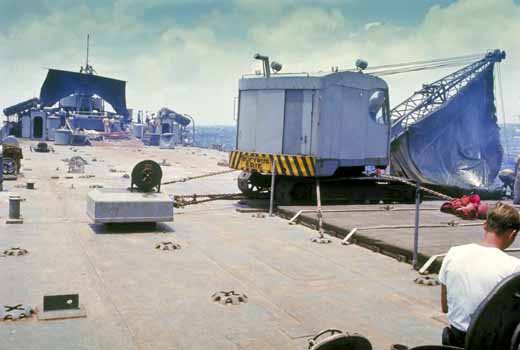One of the Last Navy Ships to Raise Sail?
By
Jim Giles
Then, LTJG, USNR
Oriental, NC
![]()
I joined the LST-902 in June 1969 as Engineer Officer. The ship was in terrible condition with many mission-limiting casualties (CASREPs). In August 1969, we sailed for Yokosuka, Japan for much-needed repairs. (The 902’s last significant industrial maintenance was in Sasebo, Japan in mid-1967. That work was to repair damage the ship received while aiding a grounded merchantman at Triton Island in June 1967.)
As we left Viet Nam on the 2,000-plus mile trip to Japan, we had many engineering problems; the starboard main engine had a cracked block (we used damage control shoring to keep the coolant from blowing out). The port main
engine had a loose flywheel. Two of the three generator engines were inoperative as well as the emergency generator. Even the general announcing system (1MC) was inoperative (The messenger of the watch roamed throughout the ship informing us of matters like, “General Quarters.”).
As we were “steaming” north to Japan in the Strait of Luzon, both main engines failed at the same time. I got the dreaded message, “Chief Engineer to the bridge.” As I entered the pilothouse, the CO, David Jardine, demanded to know what the problem was. (This was a rhetorical question, since before we left; he had asked me if I thought we would make it to Japan. I said we had no choice because if we did not get there the ship could eventually sink. We even had a CASREPed hull!). I explained that my engineers were working to get the engines going again but it was going to take “a while.” He demanded to know what I was going to do in the meantime. In frustration, I quipped, “Maybe we should try to sail the ship.” The CO looked at me sternly and said, “Make it so!”
Fortunately, LTJG Dick Wilkins, the Operations Officer, was also on the bridge as officer of the deck. He wisely interjected something like “There’s a good idea.” With that said, the situation went very quickly from tense to relief to a sense of anticipation as we realized that we could do something for ourselves. I told the CO that in addition to working on the engines I would get to work on the sails right away. (I had grown up in Massachusetts and learned to sail on Buzzards Bay. Dick as I recall was also a sailor.)
All deck hands quickly went to work rigging the awning and spare hatch covers as sails. We used the forward gun tub, the crane boom, the ship’s signal mast, and an improvised pole on deck as our masts. LTJG Bill Griffiths, the Supply Officer, came up with two sets of small boat sails from his storerooms! (Previously, those same storerooms never seemed to have any spare parts I needed though!)
For three days, we made an average of 0.75 knots enough to maintain steerageway. Meanwhile my engineers and I worked steadily to jury rig the engines to get at least one going. We got the engine with the loose flywheel to make barely 1/3 power. At higher RPMs, the engine seemed to want to shake itself off its mounting.
We eventually reached Yokosuka. There the Fleet Maintenance Officer and his staff met with the ship’s officers in our wardroom. After reviewing our work package, he said, “You men are in the worst squadron in the navy and this is the worst ship in that squadron! Given the material condition of this U.S. Navy ship, I should courts martial every one of you!” (Gulp) “However, he could see that none of us had been on board long enough to do that much damage to a ship. He concluded his short visit with, “We will fix you up.” As they left, a swarm of Japanese artisans from every conceivable shop at the Ship Repair Facility (SRF) descended upon the ship.
In three weeks, they removed every engine, pump, motor, and anything else that had parts from the ship. They overhauled and reinstalled everything. They even welded up (most) of the problems in the hull. They had to replace all our WWII kapok life rafts after ours sank when the SRF float tested them in the officers’ club swimming pool. When we left Japan, everything worked. It those three short weeks, the SRF made our ship like “new.” The crew could again be proud of their ship and return to Viet Nam to “Provide Service with Dedication.”

